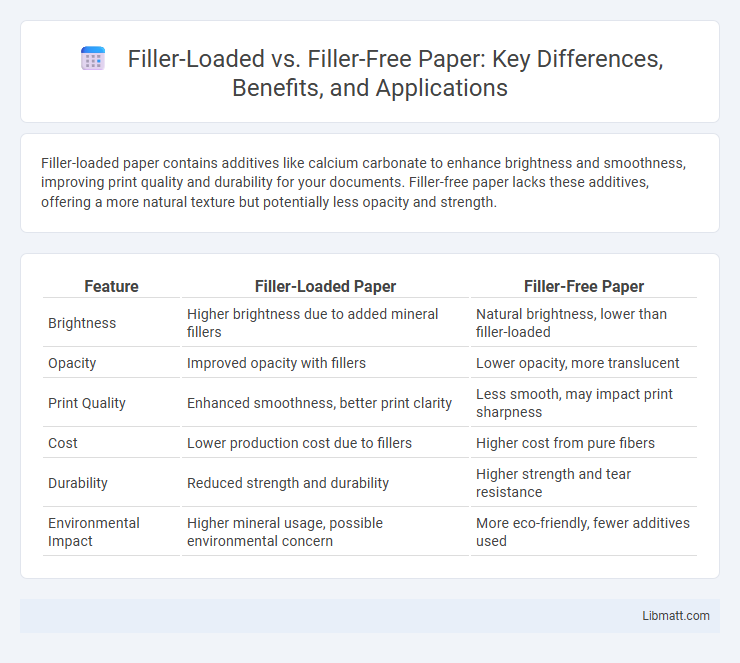Filler-loaded paper contains additives like calcium carbonate to enhance brightness and smoothness, improving print quality and durability for your documents. Filler-free paper lacks these additives, offering a more natural texture but potentially less opacity and strength.
Table of Comparison
| Feature | Filler-Loaded Paper | Filler-Free Paper |
|---|---|---|
| Brightness | Higher brightness due to added mineral fillers | Natural brightness, lower than filler-loaded |
| Opacity | Improved opacity with fillers | Lower opacity, more translucent |
| Print Quality | Enhanced smoothness, better print clarity | Less smooth, may impact print sharpness |
| Cost | Lower production cost due to fillers | Higher cost from pure fibers |
| Durability | Reduced strength and durability | Higher strength and tear resistance |
| Environmental Impact | Higher mineral usage, possible environmental concern | More eco-friendly, fewer additives used |
Introduction to Filler Loaded and Filler-Free Paper
Filler loaded paper contains minerals such as calcium carbonate or clay that improve brightness, opacity, and smoothness while reducing production costs. Filler-free paper relies solely on cellulose fibers, offering higher strength, durability, and better print quality but at increased manufacturing expense. Understanding the differences supports selecting the right paper type for applications demanding either cost-efficiency or superior performance.
What Are Fillers in Paper Manufacturing?
Fillers in paper manufacturing are fine particulate materials such as calcium carbonate, kaolin clay, or titanium dioxide added to the pulp to improve brightness, opacity, and smoothness. These fillers enhance printability and reduce production costs by lowering the amount of expensive fiber required while maintaining the paper's quality. Filler-loaded papers often exhibit increased stiffness and improved surface properties but may have reduced strength compared to filler-free papers.
Key Characteristics of Filler Loaded Paper
Filler loaded paper contains materials such as calcium carbonate or clay that improve brightness, opacity, and smoothness, making it ideal for high-quality printing and writing. This type of paper offers better bulk and stiffness at a lower cost compared to filler-free paper, which relies more on pure fiber content. Your choice depends on whether you prioritize enhanced print quality and affordability or durability and tear resistance.
Distinct Features of Filler-Free Paper
Filler-free paper is characterized by its high purity and natural fiber content, lacking inorganic fillers like calcium carbonate or clay that can reduce strength and printing quality. It offers superior durability, better ink absorption, and improved archival properties, making it ideal for documents requiring longevity and clarity. Your choice of filler-free paper ensures enhanced performance in printing and writing tasks, preserving the content without degradation over time.
Production Process: Filler Loaded vs Filler-Free
Filler-loaded paper incorporates materials like calcium carbonate or clay during production to enhance brightness, smoothness, and opacity, improving print quality and reducing costs. Filler-free paper relies solely on natural fiber content, offering higher strength and durability but often at increased production expense and environmental impact. Your choice between these papers depends on desired print performance and ecological footprint.
Performance Comparison: Strength, Smoothness, and Printability
Filler-loaded paper typically offers enhanced smoothness and printability due to the fine mineral particles that create a uniform surface, improving ink absorption and image sharpness. However, filler-free paper usually provides superior strength and durability, as it retains more natural fiber bonding, which is critical for applications requiring tear resistance and longevity. Your choice between these papers should consider the balance between print quality and mechanical performance based on the specific needs of your project.
Environmental Impact: Filler Usage in Paper
Filler-loaded paper contains minerals like calcium carbonate or clay, which reduce fiber usage and lower energy consumption during production, but these fillers can increase the paper's environmental footprint due to mining and processing impacts. Filler-free paper relies solely on natural fibers, promoting biodegradability and recyclability while minimizing chemical additives, which benefits ecosystems by reducing pollution and waste. Choosing filler-free paper can help you support sustainable forestry practices and reduce your ecological impact.
Cost Implications: Filler Loaded vs Filler-Free Options
Filler-loaded paper typically reduces manufacturing costs by incorporating inexpensive materials like calcium carbonate, leading to lower prices for consumers. In contrast, filler-free paper often demands higher-quality fibers and more intensive processing, resulting in increased production expenses and retail costs. Choosing between filler-loaded and filler-free options involves balancing cost efficiency with desired paper quality and performance characteristics.
Best Applications for Filler Loaded Paper
Filler loaded paper, containing minerals like calcium carbonate or clay, offers enhanced brightness, smoothness, and opacity, making it ideal for high-volume printing applications such as magazines, catalogs, and brochures where cost efficiency and print quality are critical. Its improved surface properties support sharp image reproduction, vibrant color output, and reduce ink absorption, which optimizes print performance for offset and digital presses. Best suited for commercial printing environments, filler loaded paper balances durability with affordability, excelling in projects that demand consistent print clarity and economic production.
Ideal Uses for Filler-Free Paper
Filler-free paper is ideal for applications requiring high-quality printing and durability, such as archival documents, fine art prints, and professional presentations. Its absence of fillers enhances print clarity, ink adhesion, and longevity, making it perfect for preserving important records or creating detailed graphics. You benefit from sharper images and longer-lasting materials when choosing filler-free paper for your critical projects.
filler loaded vs filler-free paper Infographic

 libmatt.com
libmatt.com